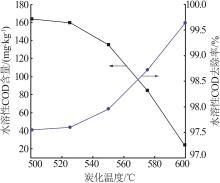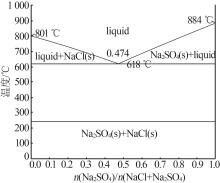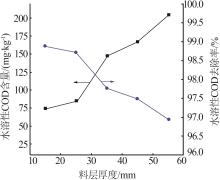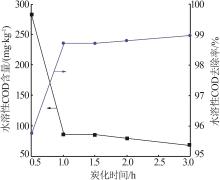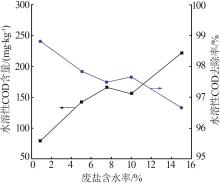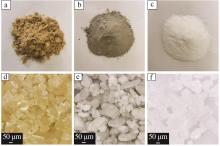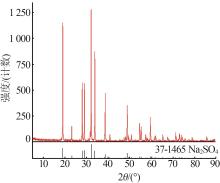Inorganic Chemicals Industry ›› 2023, Vol. 55 ›› Issue (9): 100-105.doi: 10.19964/j.issn.1006-4990.2022-0669
• Environment·Health·Safety • Previous Articles Next Articles
Study on carbonization and purification process of high COD industrial waste salt
ZHOU Zhaoan1,2( ), LI Jun1,2, LIU Xiaowen1,2, ZHOU Aiqing1,2, MAO Anzhang1,2
), LI Jun1,2, LIU Xiaowen1,2, ZHOU Aiqing1,2, MAO Anzhang1,2
- 1.Guangdong Feinan Resources Recycling Co. ,Ltd. ,Zhaoqing 526233,China
2.Engineering Technology Research Center for Comprehensive utilization of industrial solid waste copper sludge resources of Guangdong,Zhaoqing 526233,China
-
Received:2022-11-11Online:2023-09-10Published:2023-09-19
CLC Number:
Cite this article
ZHOU Zhaoan, LI Jun, LIU Xiaowen, ZHOU Aiqing, MAO Anzhang. Study on carbonization and purification process of high COD industrial waste salt[J]. Inorganic Chemicals Industry, 2023, 55(9): 100-105.
share this article
Table 3
Analysis of orthogonal experiment results"
| 因素水平分析 | 因素 | |||
|---|---|---|---|---|
| 炭化气氛 | 炭化温度 | 炭化时间 | 料层厚度 | |
影响显著值由 大到小依次为 | 炭化温度、料层厚度、炭化气氛、炭化时间 | |||
| K1 | 283.533 | 258.234 | 281.587 | 283.383 |
| K2 | 275.749 | 281.587 | 275.299 | 281.587 |
| K3 | 279.790 | 299.251 | 282.186 | 274.102 |
| k1 | 94.511 | 86.078 | 93.862 | 94.461 |
| k2 | 91.916 | 93.862 | 91.766 | 93.862 |
| k3 | 93.263 | 99.750 | 94.062 | 91.367 |
| R(K) | 7.784 | 41.018 | 6.886 | 9.281 |
| 1 | 李彦伟,陈洪法,张树立,等.废盐处置工艺与设备解析[J].中国新技术新产品,2021(2):122-124. |
| LI Yanwei, CHEN Hongfa, ZHANG Shuli,et al.Analysis of waste salt disposal technology and equipment[J].China New Technologies and New Products,2021(2):122-124. | |
| 2 | 吴骞,袁文蛟,王洁,等.工业废盐热处理技术研究进展[J].环境工程技术学报,2022,12(5):1668-1680. |
| WU Qian, YUAN Wenjiao, WANG Jie,et al.Research progress of industrial waste salt thermal treatment technologies[J].Journal of Environmental Engineering Technology,2022,12(5):1668-1680. | |
| 3 | 周海云,鲍业闯,包健,等.工业废盐处理处置现状研究进展[J].环境科技,2020,33(2):70-75. |
| ZHOU Haiyun, BAO Yechuang, BAO Jian,et al.Research progress on status quo of industrial waste salt treatment and dispo-sal[J].Environmental Science and Technology,2020,33(2):70-75. | |
| 4 | 丁志广,郭键柄,卢超.化工废盐无害化处理的实验研究[J].无机盐工业,2020,52(2):58-61. |
| DING Zhiguang, GUO Jianbing, LU Chao.Experimental study on harmless disposal of chemical waste salts[J].Inorganic Chemicals Industry,2020,52(2):58-61. | |
| 5 | 杨文振,熊萍,孙秀云,等.医药废硫酸钠盐燃烧特性及低温炭化除杂研究[J].无机盐工业,2021,53(9):76-82. |
| YANG Wenzhen, XIONG Ping, SUN Xiuyun,et al.Study on combustion characteristics of waste pharmaceutical Na2SO4 and impurity removal by low-temperature carbonization[J].Inorganic Che-Industry micals,2021,53(9):76-82. | |
| 6 | 高若峰.基于流化床的工业废盐有机物脱除的热处理机理研究[D].杭州:浙江大学,2020. |
| GAO Ruofeng.Study on heat treatment mechanism of removing organic matter from industrial waste salt based on fluidized bed[D].Hangzhou:Zhejiang University,2020. | |
| 7 | 李宁宇,孙晓蕾,邹明璟,等.医药副产含磷废盐的提纯研究[J].无机盐工业,2021,53(3):73-77. |
| LI Ningyu, SUN Xiaolei, ZOU Mingjing,et al.Study on purification of phosphorus waste salt produced by medicine[J].Inorganic Chemicals Industry,2021,53(3):73-77. | |
| 8 | 李志国,赵志刚,梁海.氰乙酸及副产氯化钠提纯工艺研究[J].精细与专用化学品,2019,27(6):16-18. |
| LI Zhiguo, ZHAO Zhigang, LIANG Hai.Purification technology of cyanoacetic acid and by-product sodium chloride[J].Fine and Specialty Chemicals,2019,27(6):16-18. | |
| 9 | 周国娥,钟红梅,梁美东.水合肼副产盐渣制小苏打新工艺研究[J].无机盐工业,2017,49(6):53-55. |
| ZHOU Guoe, ZHONG Hongmei, LIANG Meidong.Research on new production process of baking soda with by-produced salt waste in hydrazine hydrate production[J].Inorganic Chemicals Industry,2017,49(6):53-55. | |
| 10 | 张旭,张军,马宝刚,等.电氧化技术资源化处理工业废盐的中试应用[J].农药,2022,61(8):573-575,579. |
| ZHANG Xu, ZHANG Jun, MA Baogang,et al.Pilot scale application of electrooxidation technology for resource treatment of industrial waste salt[J].Agrochemicals,2022,61(8):573-575, 579. | |
| 11 | CAO Min, LIU Li, YU Zhongfen,et al.Studies on the corrosion behavior of Fe-20Cr alloy in NaCl solution spray at 600 ℃[J].Corrosion Science,2018,133:165-177. |
| [1] | BAI Chaopeng, PENG Hui, CHEN Yuting, LUO Jiang, ZHANG Shengming. Research progress of recovery,purification and recycling of ruthenium from scrap ruthenium materials [J]. Inorganic Chemicals Industry, 2024, 56(4): 24-33. |
| [2] | JIN Suna, LÜ Ruiliang. Research progress of heterogeneous catalytic ozonation for industrial wastewater treatment [J]. Inorganic Chemicals Industry, 2024, 56(3): 28-38. |
| [3] | ZHANG Yaqi, CHEN Xiping, SUN Ningning. Study on preparation process of cryolite from anode carbon slag by catalytic decarburization [J]. Inorganic Chemicals Industry, 2024, 56(3): 91-97. |
| [4] | WEI Tianshun, JI Lijun, SHENG Yong, CHEN Kui, WU Yanyang, WU Bin. Study on fractional crystallization process of ammonium sulfate and sodium sulfate in high salt wastewater [J]. Inorganic Chemicals Industry, 2024, 56(1): 102-106. |
| [5] | CHEN Yanmeng, MO Huiling, ZHONG Jiamei, YANG Pengfei, LAN Junfeng. Study on preparation process of porous calcium carbonate by carbonization [J]. Inorganic Chemicals Industry, 2023, 55(8): 102-108. |
| [6] | WANG Liping, LI Chao, CHANG Ning, CAO Kun, GAO Guimei, ZHANG Yunfeng, HONG Yu, TU Ya, ZHAO Jianqiang. Research progress of recovery technology of valuable elements from coal gangue [J]. Inorganic Chemicals Industry, 2023, 55(7): 10-17. |
| [7] | REN Teng, LI Shengdong, WANG Dexi, CHU Fuzhou, SHAO Lixin. Numerical simulation analysis of influence of jet position on mixing effect of carbonization reactor [J]. Inorganic Chemicals Industry, 2023, 55(7): 109-114. |
| [8] | QU Xiaoyuan, ZHENG Qiang, FAN Yuanyang, LIU Haili, DENG Xiaoyang, LI Xue. Study on preparation of large cube calcium carbonate by secondary carbonization of dolomite [J]. Inorganic Chemicals Industry, 2023, 55(7): 58-64. |
| [9] | WANG Benlei, ZHANG Guisheng, JIANG Lingyun, LI Chen, WANG Pengfei, LI Jixia, ZANG Jiazhong. Study on preparation process of rhodium trichloride by roasting recovery technology from waste rhodium solution of carbonyl synthesis [J]. Inorganic Chemicals Industry, 2023, 55(6): 104-108. |
| [10] | LU Dachuan, GU Weihua, ZHAO Jing, ZHUANG Xuning, DONG Bin, BAI Jianfeng. Research progress of influencing factors of pyrolysis of municipal sludge and residue recycling [J]. Inorganic Chemicals Industry, 2023, 55(5): 8-15. |
| [11] | CHEN Yujue, ZHANG Liangjun, KUANG Huan, JIANG Manwen, XIAO Li. Study on roasting and recovery process of waste lithium iron phosphate powder with sodium bisulfate [J]. Inorganic Chemicals Industry, 2023, 55(3): 113-117. |
| [12] | LI Li,LI Yu,JIN Yan,QIU Jun,YANG Ying,ZHANG Yonghong,XIAO Fang,YU Jianguo. Key technology and application of lithium extraction from produced water in high sulfur and high hardness gas fields [J]. Inorganic Chemicals Industry, 2023, 55(1): 74-80. |
| [13] | WANG Bingjian,QI Daozheng,CHEN Deng. Degradation processes and mechanism of tricalcium aluminate in different sulfate environment [J]. Inorganic Chemicals Industry, 2022, 54(8): 119-124. |
| [14] | ZHENG Sanqiang,LI Xingbin,LUO Xingguo,WEI Chang,HUANG Xing,DENG Zhigan,LI Minting. Production and control of water insoluble substance in sodium sulfate produced by NaCl-Na2SO4 co?production [J]. Inorganic Chemicals Industry, 2022, 54(8): 90-95. |
| [15] | ZHANG Shaokang,ZHAO Hua,LIU Runjing. Study on macro?kinetics of carbonization reaction of ammonia alkali salt sludge [J]. Inorganic Chemicals Industry, 2022, 54(6): 120-124. |
| Viewed | ||||||
|
Full text |
|
|||||
|
Abstract |
|
|||||
|
||
